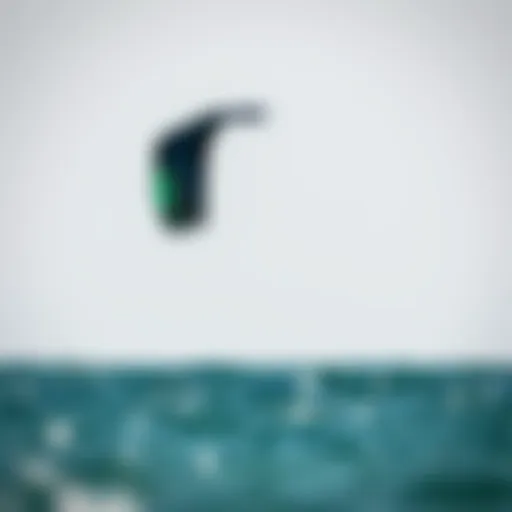Essential Supplies for Kitesurfing: A Complete Guide
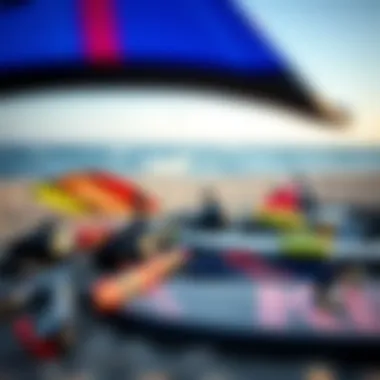
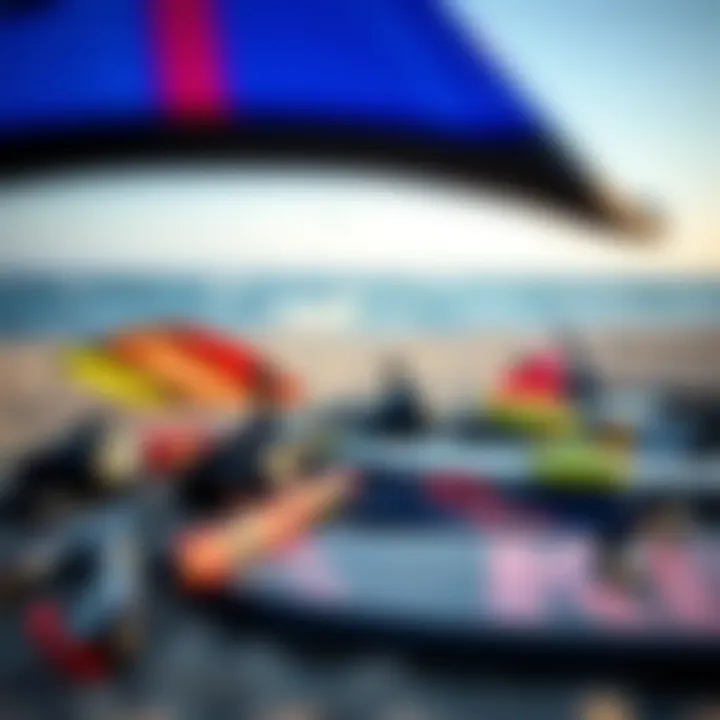
Intro
Kitesurfing, a sport that seamlessly blends the thrill of surfing with the excitement of flying, has gained popularity among water enthusiasts. Whether you're zipping across the waves or catching air under the blazing sun, having the right gear is crucial for a safe and enjoyable experience. This article will guide you through the essentials you need to take your kitesurfing to the next level, whether you're just starting or looking to upgrade your existing setup.
Kitesurfing demands a harmonious dance between equipment and the environment. Understanding what supplies to bring not only influences your performance but also enhances your overall enjoyment of the sport. Let’s delve into the essentials, covering everything from the types of kites suited to different wind conditions to the nuances of choosing the perfect board.
Gear Selection
In this section, we'll explore the vital equipment that every kitesurfer should consider. Choosing the right gear can make a world of difference in your performance and safety.
Types of Kites
When it comes to kites, one size doesn’t fit all. Kitesurfing kites typically fall into two primary categories: fixed-bridle kites and C-shaped kites. Fixed-bridle kites are known for their stability and ease of use, making them an excellent choice for beginners. Conversely, the C-shaped kites offer enhanced performance for advanced riders, allowing for dynamic aerial tricks and better control.
You might also encounter leading edge inflatables (LEIs) and foil kites. LEIs are great for those who enjoy versatility; they can handle different wind conditions and provide buoyancy, helping you stay afloat even in weaker winds. Foil kites, on the other hand, are lighter and pack down smaller, making them ideal for those looking to travel light.
Choosing the Right Board
Selecting a board involves more than just picking a pretty one. The choice largely depends on your skill level, riding style, and the conditions you plan to surf in. In general, boards can be classified into two categories: directional and twin-tip boards.
- Directional boards are designed for wave riding, allowing for a more surf-like experience on the water. They usually require you to ride with your toes pointing forward, making them less suitable for beginner riders who are still finding their feet.
- Twin-tip boards, while allowing you to ride in either direction, offer a more forgiving learning curve. This versatility helps beginners focus on technique without the added pressure of directional riding.
Consider the board's width and length as well. Wider boards provide better stability and allow for easier upwind rides, which can be beneficial when the wind kicks up. Longer boards can help you catch more speed.
"Choosing the right equipment isn't just about performance; it's about enjoying the ride safely and confidently."
As you sift through kitesurfing equipment, don't forget to also check for quality brands that offer reliable gear. Research and read reviews or join kitesurfing forums, such as those on Reddit, where real-life experiences can be more telling than any advertisement.
Once you have your kite and board sorted, it’s time to consider your skills and how to improve them. Stay tuned as we shift our focus to skill development in the next section.
Preamble to Kitesurfing Supplies
Understanding kitesurfing supplies is essential for anyone looking to engage in this thrilling watersport. From the gear you ride to the accessories that enhance your experience, having the right equipment can make a world of difference. As kitesurfing combines elements of wind, water, and skill, the interaction between these elements and your gear is critical for both performance and safety.
The Evolution of Kitesurfing Gear
Kitesurfing gear has come a long way since its inception, evolving dramatically in response to advancements in technology and rider demands. The early days saw rudimentary kites that were often difficult to control and prone to issues like collapsing mid-air. Nowadays, inflatable kites are the go-to choice, designed with precision for stability and maneuverability. Modern kites feature advanced materials that are lighter yet stronger, allowing for enhanced performance without compromising safety.
The development of twin-tip boards also revolutionized the sport, allowing riders to go in either direction without needing to turn around. As the sport has grown, so too has the specialization of equipment. Dedicated boards for freestyle, wave riding, or racing cater to diverse riding styles, offering choices that make the ride enjoyable and match the conditions.
Why Proper Equipment Matters
Proper equipment is more than a luxury; it's a necessity for a safe and enjoyable kitesurfing experience. Here are key points emphasizing why choosing the right gear is crucial:
- Safety: Quality kites and harnesses are designed with safety systems that ensure quick releases in emergencies. Not having the right equipment can lead to serious accidents.
- Performance: The right setup can significantly boost your performance. A properly sized kite enhances lift and speed while the board facilitates control over different water conditions.
- Comfort: Comfort plays a substantial role in your overall enjoyment. A well-fitted harness minimizes discomfort during extended sessions.
- Adaptability: Weather conditions can change rapidly. Having the right equipment allows you to adapt effectively, whether the wind picks up or drops entirely.
"Choosing the right kitesurfing gear isn't just about looking cool; it can literally make the difference between a thrilling ride and a harrowing experience."
In summation, knowing about kitesurfing supplies, the evolution of gear, and the significance of proper equipment lays a solid foundation for any aspiring kitesurfer. Understanding your supplies not only cultivates a profound respect for the sport but also promotes a safer and more enriching experience on the water.
Kites: The Heart of Kitesurfing
Kites serve as the very core of kitesurfing, acting as the main source of power and maneuverability on the water. Understanding the various aspects of kites is vital, not just for enthusiasts but for anyone keen on diving into this exhilarating sport. A kite isn't just a piece of fabric and string; it’s the lifeblood that propels riders across the waves, making its selection crucial.
Types of Kites
Inflatable Kites
Inflatable kites have become the go-to choice for many kitesurfers. Their significant feature is the inflatable leading edge, which provides stability and ease of control. These kites are popular due to their versatility and beginner-friendly nature. They hold air, creating an airfoil that delivers lift, and extend the kite’s range of wind conditions.
The main advantage of inflatable kites is their performance in different wind conditions. Whether it's a light zephyr or a stronger breeze, inflatable kites can handle it all. However, they might not perform as well as foil kites in super high winds. That said, their ability to relaunch from the water easily is a game changer for those just starting out. They're indeed a beneficial choice for novices.
Foil Kites
Foil kites bring a different flavor to the game. They consist of multiple cells that fill with air, creating a design that allows them to cut through the wind with remarkable efficiency. These kites have a reputation for being very lightweight and having superb lift. Foil kites shine in light wind conditions and are often preferred by seasoned riders looking for something special.
One important characteristic of foil kites is their ability to stay aloft more easily than inflatable kites in consistent winds. They can be packed down smaller, making them perfect for travel. However, the trade-off often comes in terms of relaunching from the water, which can be a bit tricky if one doesn’t have the right technique. Still, for those who seek precision and performance, they are an intriguing option.
Hybrid Designs
Hybrid kites blend features from both inflatable and foil kites, aiming to offer the best of both worlds. They provide the stability and ease of control found in inflatables while incorporating some of the lightweight advantages characteristic of foils. This compromise makes them a popular choice for riders who value versatility.
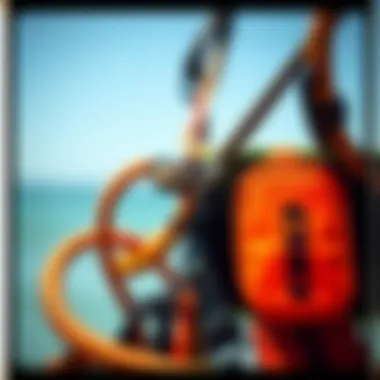
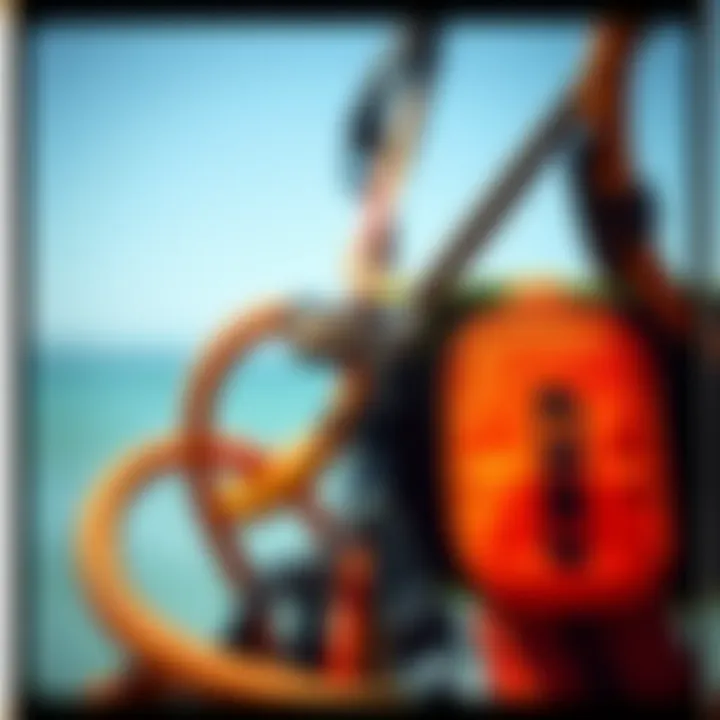
The standout feature of hybrid kites is their adaptability. They perform decently in various wind conditions and are suitable for many riding styles. However, hybrid kites might not specialize particularly well in any area, which might dissatisfy those who have very specific performance expectations. Still, they provide a good middle ground for those exploring the vast world of kitesurfing.
Choosing the Right Kite Size
Choosing the right kite size is as crucial as selecting the kite style. The size is determined primarily by the wind strength and the rider's weight. A kite that is too large for light winds can be challenging to control, while a small kite in strong winds may lack the power needed to ride effectively. Each size caters to different wind conditions and rider abilities. Performing some research and understanding the typical wind patterns in your area can make all the difference.
Kite Construction Materials
Kite construction materials can influence sturdiness and overall performance. The fabric quality, typically ripstop nylon or polyester, must endure the rigors of the ocean. The stitching and assembly methods also impact durability, which is paramount for ensuring the kite can withstand various environmental conditions. Riders must consider their preferences and experiences when selecting kites to ensure safety and performance remain at the forefront of their adventure.
"The right equipment is half the battle in kitesurfing; it can make the difference between a good day and a bad one on the water."
As you dive deeper into kitesurfing, recognizing these nuances regarding kites will elevate your experience and understanding of the sport. Innate power, stability, and adaptability of the kite are central to enjoying the ride. Tune into the relationship between the kites you choose and your riding ambitions, enabling an enriching kitesurfing adventure.
Boards: Riding the Waves
Kitesurfing is about balancing the forces of wind, water, and your own body. When it comes to this unique dance, the board you choose surely plays a pivotal role in your performance on the waves. A suitable board can significantly enhance your kitesurfing experience, providing better control and comfort as you ride through the water. Whether you are carving on the surface or trying to get some air, understanding the different types of boards available will help set you on the right path.
Board Types Overview
Choosing the right board is essential. There are three primary types of boards to consider: directional boards, twintip boards, and foil boards. Each of them has its own unique characteristics, performance styles, and recommended usage scenarios.
Directional Boards
Directional boards are typically designed for riding in one direction, like a surfboard. This specific design allows harnessing the waves more effectively, making it a favorite among those who enjoy surf-style kitesurfing. With a longer and narrower shape, directional boards strike a balance between speed and maneuverability, often featuring fins that help with grip on the water.
Its main characteristic is the single or multiple fins on the bottom that enable the rider to carve through the waves with precision. Riders looking for a more engaged experience often gravitate toward directional boards because of their ability to connect with the ocean beneath. However, they do require a steeper learning curve, as one needs to master the art of riding in a consistent direction.
Twintip Boards
When it comes to versatility, twintip boards take the cake. With a symmetrical design and a flat bottom, these boards can be ridden in either direction, making them very user-friendly, especially for beginners. Their unique feature is the twin tip design that makes transitions easier and allows riders to switch directions without difficulty. This adaptability is precisely what makes twintip boards popular.
If you’re just getting into kitesurfing or prefer tricks and jumps, a twintip board may serve you well. However, while they excel in stability and ease of use, they might not offer the same performance in waves as directional boards do.
Foil Boards
Foil boards have become a trendy choice in recent years among intermediate to advanced kitesurfers. They are equipped with a foil that lifts the board above the water’s surface, allowing for smooth gliding even in relatively low wind conditions. The key characteristic here lies in the hydrofoil, which significantly reduces drag and enables riders to carve through waters with minimal resistance.
This advantage comes with added thrill, as the sensation of flying above the water creates an exhilarating experience. However, riding a foil board is not to be taken lightly: they require a stable balance and control that may challenge new riders.
Board Features to Consider
When selecting your board, consider various features that can influence your riding experience:
- Length and Width: Longer boards provide more stability while shorter boards offer agility. Wider models tend to add buoyancy.
- Weight: A lightweight board can enhance performance and ease of transport but may sacrifice durability.
- Flex: The board's flex impacts the ride feel. Stiffer boards might provide better speed, while flexible boards are usually more forgiving over choppy waters.
Maintaining Your Board
Proper maintenance can prolong your board’s life. Clean it after each use to remove sand and saltwater. Store it in a cool, dry place. Check for any damages, especially around the fins and flex zones. Repair any issues before your next use, as this ensures safety as well as efficiency in performance.
Harnesses: Connecting the Rider
When it comes to kitesurfing, the harness serves a vital role, acting as the bridge between the rider and the kite. This piece of equipment is not just about attaching oneself to a kite; it’s about comfort, control, and safety. Choosing the right harness can significantly enhance your riding experience, making it more enjoyable while also ensuring that you can maneuver effectively in different wind conditions. Moreover, a well-fitted harness can help prevent potential injuries by distributing pull forces more evenly across your body.
Different Types of Harnesses
Several types of harnesses cater to different riding styles and preferences. Choosing the right one often depends on the individual’s riding style, personal comfort, and the type of kitesurfing they intend to pursue.
Seat Harnesses
Seat harnesses are designed to sit lower on the body, providing support around the hips and thighs. One of the key characteristics of seat harnesses is their ability to distribute weight and stress evenly across these areas, helping to reduce back strain during rides. Many riders gravitate toward seat harnesses because they provide a snug fit with minimal movement, allowing for improved control over the kite and board.
A unique feature of seat harnesses is their extra padding, which offers enhanced comfort during prolonged sessions on the water. Additionally, the lower attachment point helps prevent the rider from being pulled back excessively during gusty conditions, making it a preferred choice for beginners and those just starting out in kitesurfing. However, it’s worth noting that some riders may find the additional bulkiness restricting, particularly when attempting advanced maneuvers.
Waist Harnesses
Waist harnesses sit higher up, around the waist area, and are often favored for their freedom of movement. This is one of their standout traits, as they allow riders to perform tricks and turns more easily thanks to a more unrestricted range of motion. Many experienced kiteboarders find waist harnesses to be a go-to option for their versatility and adaptability.
With their higher attachment point, waist harnesses can often provide better leverage and connection to the kite. This becomes especially important in high-energy conditions, where the control provided by a waist harness can make all the difference. However, some riders may experience discomfort from the harness sliding up during jumps, which could become a massive annoyance if proper fit isn’t maintained.
Fitting and Comfort
Achieving the right fit is essential when it comes to harnesses. If a harness is too tight, it may restrict movement; too loose, and it can shift during use, causing chafing or even falling out.
In terms of comfort, many modern harnesses now incorporate adjustable straps, allowing riders to customize the fit to their liking. This ensures an optimal connection while also addressing any individual comfort preferences. When selecting a harness, it’s crucial to consider how it feels while on land and during practice runs on the water. A comfortable fit enhances not only performance but also the overall enjoyment of the sport, making it a fundamental part of kitesurfing gear.
"Taking the time to find the right harness can make or break your kitesurfing experience."
Ultimately, understanding the different types of harnesses available, their distinct characteristics, and ensuring a good fit will considerably enhance your kitesurfing journey, allowing for greater enjoyment and skill advancement on the water.
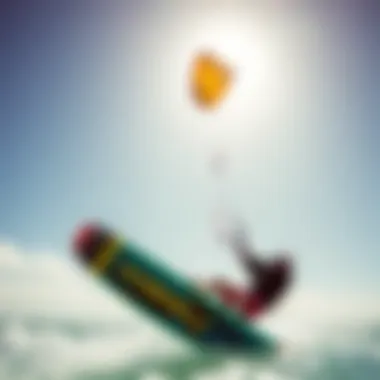
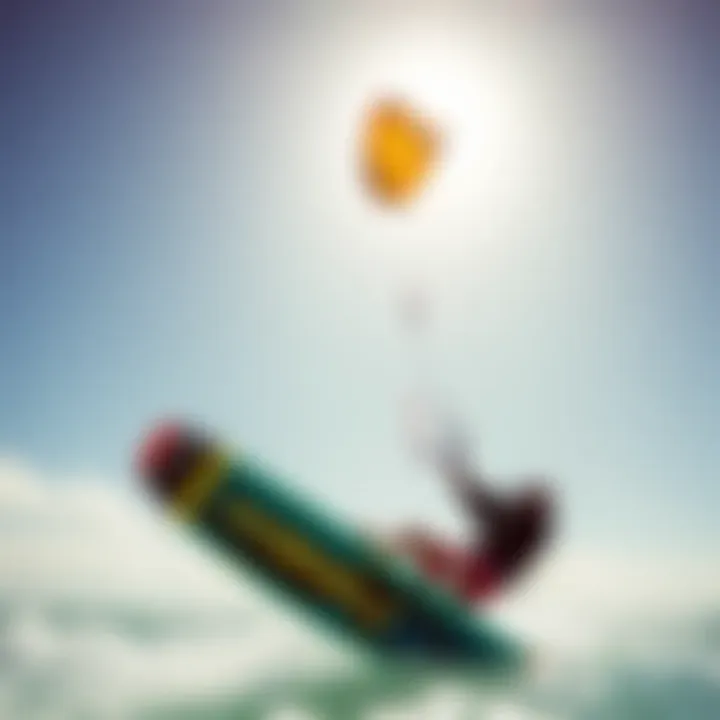
For further reading on kitesurfing gear, you can check out resources such as Wikipedia - Kitesurfing or community discussions on Reddit - Kitesurfing.
Ending
Selecting the appropriate harness is not just a decision made on a whim; it goes hand-in-hand with one’s kitesurfing ambitions. Whether leaning towards a seat or waist harness, understanding your needs and comfort will undoubtedly enhance your time spent on the water.
Control Systems: Steering the Kite
When it comes to kitesurfing, control systems are like the steering wheel of a car. They allow riders to maneuver their kites with precision, which in turn enhances both safety and performance on the water. Understanding the mechanics behind these systems can make all the difference, whether you're a seasoned pro or just getting your feet wet. Proper control allows for better kite handling, which is crucial for executing tricks, managing speed, and reacting to changing wind conditions.
Lines and Bar Mechanics
At the heart of any kitesurfing control system are the lines and bar. The lines, typically made from high-strength materials, connect the kite to the control bar. This setup not only allows for control over the kite's position in the wind but also facilitates power and depower, making it vital for adjusting to varying conditions.
- Line Length: Most kites come with standard line lengths of 20 to 25 meters, but the right length can depend on your skill level and riding style. Shorter lines offer quicker response times, while longer lines provide a better range and power potential.
- Control Bar: The control bar serves as the primary interface between the rider and the kite. Riders should ensure that the bar is comfortable to hold and fits well with their hands. Various bars come equipped with additional functions, such as adjustable widths, that cater to individual preferences.
- Depower Options: Many control bars have a depowering mechanism that allows riders to easily adjust the kite's power while riding. This can come handy in gusty conditions where precise power control is essential.
Knowing how to read your lines is key. If they are tangled or frayed, it can lead to catastrophic failures. Regularly inspect and take good care of these components to ensure a smooth ride.
Safety Systems Explained
Safety should always be a kitesurfer's top priority. Modern kitesurfing gear incorporates various safety systems aimed at minimizing risks during riding. These include:
- Quick Release Mechanism: This is perhaps the most critical feature in a kiter's safety system. It allows riders to detach themselves from the kite instantly in emergencies. Make sure to familiarize yourself with how your specific quick release works before hitting the water.
- Leash Systems: A safety leash connects the rider to the kite, preventing it from drifting away if you lose control. Understanding how to properly attach and detach the leash can save you from losing your gear.
- Safety Flags: Many kites feature a safety flagging system that helps stabilize the kite when it’s depowered. This prevents it from rolling around in the wind, which can be particularly dangerous for the rider.
“A good safety system is like a parachute; you don’t want to have to use it, but if you need it, you want it to work.”
Carefully assess the safety features of your gear before you ride. Do some research, read manufacturer instructions, and, if possible, ask experienced kitesurfers for their opinions on the effectiveness of the safety systems they use.
These components form the backbone of kitesurfing control systems. By understanding how they work and maintaining them properly, kiteboarders can enjoy their sport with the confidence that they can steer and respond effectively to whatever the winds throw their way.
Safety Gear: Prioritizing Protection
In the thrilling world of kitesurfing, where some days the wind can play nice and others it can whip up a tempest, prioritizing safety gear is non-negotiable. Just like a sailor wouldn’t venture out without their life jacket, kitesurfers must equip themselves with essential safety items to navigate the unpredictable nature of the sport. Not only does this gear protect you from the elements and potential accidents, but it also enhances your confidence on the water, allowing for a more enjoyable experience.
Helmets and Impact Vests
When you think about safety in kitesurfing, helmets and impact vests come to mind first. These critical items are your first line of defense against head injuries and other unfortunate encounters with water or equipment. Helmets are designed to absorb impact and often come with features that offer excellent ventilation, which is crucial when you're out in the sun.
An impact vest, on the other hand, cushions your body against the quicker roll of a fall or a smack against the board during an unexpected wipeout. These vests not only protect your torso but some also ensure better buoyancy, giving you extra help if you find yourself struggling in choppy waters.
"Safety isn’t just a requirement; it’s a prerequisite for enjoying every moment on the water."
Personal Flotation Devices (PFDs)
Personal flotation devices aren’t just for the newbies; they’re essential for every kitesurfer. These vests or buoyancy aids keep you afloat when you're more focused on your next trick than where you left your board. One of the notable aspects to look for in a PFD is its ability to allow freedom of movement while still providing the necessary support. You wouldn’t want to feel constricted while attempting that jump you've been practicing.
There are many types of PFDs on the market, from minimalist styles that barely feel like you're wearing anything to more robust models with added pockets for essentials. Regardless, the right PFD can mean the difference between a scary situation and a manageable one if things take a turn for the worse.
Wetsuits and Appropriate Attire
Don’t underestimate the power of wearing the right clothes when kitesurfing. Wetsuits protect you from the cold water and wind chill, helping maintain core body temperature. Depending on where you live, the thickness and style of wetsuit can significantly vary. Some are designed for tropical waters, thin and flexible to allow maximum movement, while others are thicker and insulated for cold climates.
Aside from wetsuits, choosing the correct attire is also about ensuring that your gear is functional as well as sleek. Think about rash guards and other UV-protective clothing that keep you shielded from the sun’s harsh rays while allowing you to move freely. Cold weather doesn't have to put a damper on your kitesurfing ambitions, and a smart selection of gear can help keep you comfortable and safe—no matter the conditions.
Accessories: Enhancing the Experience
Accessories in kitesurfing might seem like optional add-ons at first glance, but they play a pivotal role in heightening the overall experience on the water. The right accessories not only contribute to comfort and efficiency but also enhance safety and performance, ensuring that you are well-prepared for any situation while out kiting. Selecting accessories tailored to your needs is essential to get the most out of your sessions and make those great moments last even longer.
Foot Straps and Pads
When it comes to kitesurfing, foot straps and pads might be the unsung heroes in your gear list. They anchor your feet to the board, providing the necessary grip and support to execute tricks, turns, and jumps with confidence. The pressure and weight distribution on your feet can affect your ride significantly. Therefore, the choice of foot straps and pads is no small potato—it has a direct impact on your performance.
There are various styles to consider:
- Adjustable Foot Straps: Allow for personalized fitting, accommodating thickness of wetsuits or the foot size, which can change with water temperature.
- Foot Pads: These can vary in thickness and material. A thicker pad often means softer landings; however, an ultra-thin pad provides more direct board feel.
Tips for Choosing Foot Straps and Pads:
- Fit Matters: Try on different combinations to see what feels right.
- Material Quality: Look for durable materials that can withstand wear and tear.
- Weather Considerations: Certain materials might feel more comfortable in warmer or colder climes.
Selecting good foot straps and pads can help keep you connected to the board while eliminating the risk of losing your footing, ensuring that you are not left floundering when the wind or waves pick up.
Kite Bags and Travel Accessories
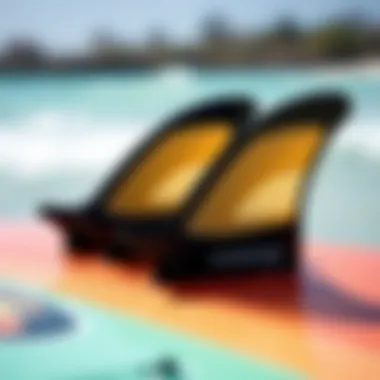
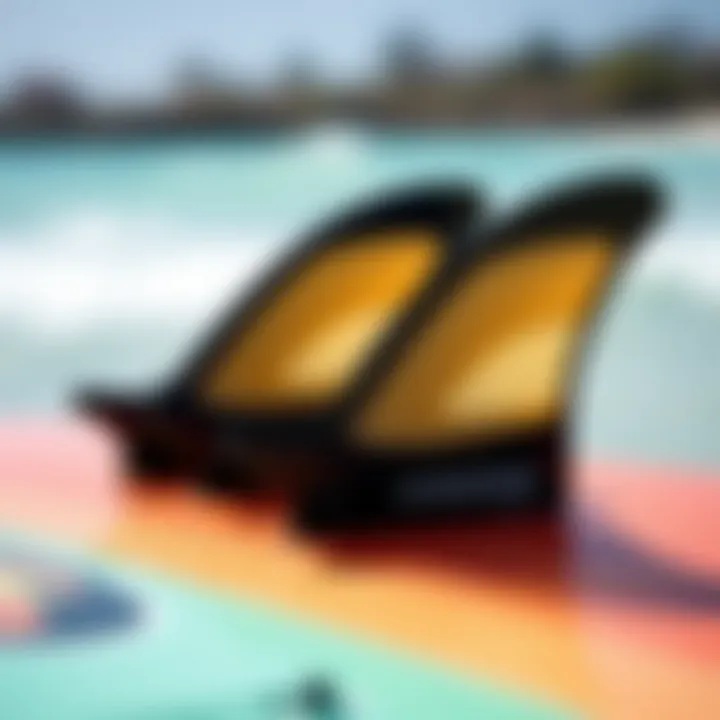
For those who have a zealous desire to explore new spots, kite bags and travel accessories become indispensable. Properly packing your gear not only protects it during transit but also makes it easier to transport, allowing you to chase the best wind and waves around the globe.
Consider the following when choosing your kite bags and travel accessories:
- Size and Capacity: Look for bags that can fit all your kites, boards, and accessories snugly. Size options can vary, so choose one that can accommodate current gear and any future additions.
- Padding and Protection: Ensuring your equipment has the cushioning it needs can save you from costly repairs or replacements. Bags with reinforced areas tend to hold up better.
- Ease of Carry: Straps and wheels can make a significant difference during travel. Bags designed with these in mind enhance your mobility and comfort.
A few smart travel accessories include:
- Travel Repair Kits: It's always wise to pack a few essentials for quick fixes.
- Waterproof Gear Bags: Keeping your dry clothes separate from wet gear prevents unwanted odors and mildew.
- Portable Pump: An inflatable kite is only as good as its inflation, so a compact, efficient pump can save you time and energy.
In summary, kite bags and travel accessories are not just practical, they ensure you arrive at your destination ready to kite. With gear in good condition and easy to transport, you can focus on what really matters—riding the waves and enjoying the breeze.
"Accessories are not just enhancements; they are crucial to making your kitesurfing journey enjoyable and safe."
By understanding the breadth and depth of available accessories, kitesurfing enthusiasts can take those vital steps toward maximizing their experience on the water.
Kitesurfing Maintenance and Care
Taking care of your kitesurfing equipment isn't just a chore; it's a crucial part of the sport that can mean the difference between a thrilling ride and a potential mishap. Regular maintenance ensures your gear operates at peak efficiency and can save you a pretty penny in repairs down the line. Enabling you to enjoy the waters safely, proper maintenance also extends the lifespan of each component, from kites to boards and harnesses.
Cleaning Your Equipment
Keeping your kitesurfing gear clean is not simply about aesthetics. Salt water, sand, and dirt can wear down the materials of your equipment, affecting its performance. To start off, rinse your kite and board thoroughly with fresh water after each session. This simple act removes salt and sand, which can lead to corrosion and wear, especially around seams and connections.
- Kite Cleaning:
- Board Maintenance:
- Make sure to pay attention to the leading edge and trailing edge. These parts are essential for kite performance and can be easily damaged by debris.
- Check for tears or punctures while rinsing. If you spot a damage, it's better to address it immediately rather than delaying repairs.
- After rinsing your board, inspect the bottom for scratches or nicks. Minor damages can be repaired with a bit of polyester repair resin, keeping your ride as smooth as possible.
- Don’t forget the foot straps and pads. Give them a clean too. Wet toes don't mix well with sand and grime, affecting your grip.
After you've given everything a good scrub down, it’s recommended to let your gear dry completely before storing it away. This helps avoid mold and unpleasant odors.
Storage Tips
The way you store your kitesurfing equipment can have a massive impact on its durability. If you think just tossing everything into a garage or shed is enough, think again. Here are some key tips to keep your gear in top-notch condition:
- Keep it Dry:
- Avoid Direct Sunlight:
- Proper Folding:
- Moist environments breed mold and mildew. Store your kitesurfing gear in a dry spot, ideally in a bag that allows some airflow.
- Prolonged exposure to the sun’s rays can break down materials, causing premature wear, particularly in kites and harnesses. Store them in a shaded area.
- When storing your kite, fold it neatly rather than stuffing it in a bag haphazardly. This helps maintain its shape and makes it easier to use next time.
- For boards, if possible, keep them mounted on wall racks or covered to prevent unnecessary scratches or pressure points.
Following these cleaning and storage guidelines will go a long way in preserving your investment. 🎾
"A stitch in time saves nine" - taking care of your gear today means fewer headaches tomorrow.
In the end, regular maintenance and thoughtful storage are the keys to enjoying kitesurfing for seasons to come, allowing you to ride the waves confidently.
Epilogue: Investing in Kitesurfing Supplies
When it comes to kitesurfing, one cannot simply gloss over the importance of investing in quality supplies. This sport is not just a leisurely activity; it's an exhilarating blend of skill, balance, and the elements, which means your gear can make or break your experience. Understanding this fundamental fact is pivotal for both newcomers and seasoned kiteboarders alike.
Investing in high-quality kitesurfing gear ensures safety, enhances performance, and can even prolong the lifespan of your equipment. While it may be alluring to chase after the cheapest options available, this can be a false economy. Lower-priced products might seem economical initially, but they often lead to quicker wear and tear, potentially rendering them unsafe or ineffective in the long run.
Considerations when investing include:
- Type of Gear: Ensure you're opting for gear suited to your level of expertise; novice kits differ significantly from those designed for advanced riders.
- Brand Reputation: Stick with well-known brands such as Cabrinha or Naish, which have built a reputation for reliability and innovation.
- Local Conditions: Think about the climate and water conditions of your usual spots; some equipment performs better in certain environments than others.
"Quality is remembered long after the price is forgotten."
Choosing the right gear means you can focus on the thrill of kitesurfing rather than constantly worrying about your equipment failing mid-ride. Proper gear doesn't just support your performance; it’s an investment in your safety.
Weighing Quality vs. Cost
Finding the balance between cost and quality is often a daunting task for many. The market is flooded with options at various price points, and it can be tempting to grab the bargain. Yet, it’s crucial to see beyond the sticker price. Higher-quality gear often integrates advanced technologies aimed at improving user experience. Here’s what you should think about:
- Durability: Higher-end products use materials that withstand harsh conditions and abuse from both water and sun.
- Performance Features: Equipment with added features often provides better control, leading to improved skills over time.
- Warranty and Support: Established brands usually offer warranties and customer service, giving you peace of mind with your purchase.
The Importance of Research
Before making any purchase, research is your best friend. Understanding the specifics about kites, boards, and safety gear can save you from making costly mistakes. Dive into forums such as Reddit, or visit kiteboarding.com where enthusiasts share their personal experiences and reviews of gear.
Consider checking resources like Wikipedia for technical insights and Britannica for a broader overview of the sport.
Moreover, visiting local shops often provides the advantage of seeing gear up close and, in some cases, testing it out. Engaging with local riders can provide unique insights and recommendations that you might not find online.
Ultimately, spending time to research not only helps in understanding what to buy but also enhances your overall kitesurfing experience. The right choices can open up a new world of riding, enabling you to fully enjoy this electrifying sport.







